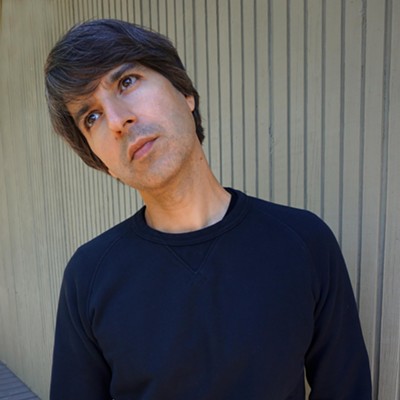So when video artist Vikki Dempsey was asked to curate the middle section of a three-part show at the Museum of Contemporary Art--aka MOCA--she collected a bunch of visual artists and, beyond the one-word theme, gave them free rein to do what they wanted.
"It's not a new idea to talk about identity in art work, but it's important to come back to," says Dempsey.
The 20 artists she gathered from Tucson as well as around the country are all women, all working with a camera. Dempsey's section is sandwiched between the other two exhibits in Lights, Camera, Action, a cumulative show ongoing through the summer. Lights ... opened a month ago and is curated by Elizabeth Cherry, who came up with the idea for the triple-header show. In early August, Joyan Saunders will install a video performance piece.
For Camera ... , Dempsey specifically collected artists who use video or photography to explore the subject of identity.
"When video first came about, it was primarily a tool to investigate formal elements of the technology itself, both on and off screen. The inclination to turn the camera around, to look at one's own image, evolved pretty naturally," explains Dempsey.
But she adds, "By finding identity, we come back to community."
The impetus for the show grew out of Dempsey's reading of work by bell hooks as well as Susan Griffin. Both authors talk about love and community and women's search for communion and suggest that its existence is found in the body--both the individual corpus and the broader body politic.
"I don't think you'd have the communion if men were included in this show," she says.
Dempsey qualifies: "Well, certain men would address the issue of identity in a way that's just all about them."
Unlike the Lights ... section where the artists are consciously exploring the medium, where everything lights up, the Camera ... section is content-driven.
"The camera is just the medium to express a feeling or a thought. Some of the artists are showing videos, some are showing still images. Several are presenting interactive and multi-media work," explains Dempsey.
For example, Janet Bardwell's Pussy Pride explores the idea of being a girl. Her performance stills come from cheers she's been doing about being a girly girl--not really part of her own identity as a child, but certainly prevalent in culture today.
There's Seed, a video installation that beckons the viewer to stick their head into a slit of fabric.
"It's very vaginal," explains Dempsey. "You see a slowed-down video image of a nude woman eating a pomegranate, the blood-red dripping down her body. Interestingly, this piece is by Andrea Hall, who, at 50, is one of the oldest artists in the show. It kind of harkens back to earlier artwork exploring identity."
While these women focus on body image or socialization, others investigate ethnicity or sexuality or impending motherhood. Things That She Carries, by Young Bok Hung, invites the viewer to follow links on a computer screen that meander through a diary journey of her own Korean American culture--a generational trip of perceptions of her mother's, her daughter's and her own cultural struggles.
"Identity is in a constant state of negotiation," offers Dempsey. "One of the artists is pregnant now, and so her piece focuses on this evolving experience. And another deals with a lesbian's de-dyking the house for a visit by her parents whom she's not yet ready to come out to."
All of the work, says Dempsey, is pretty inward-focused. "But it's always an avenue to engage the audience. Art just does that."
Bringing together 20 artists in an organized way is a challenge. But Dempsey also recognizes where her own vision has easily stepped in to keep things together.
"Ironically my life is all about change these days. So the process--and product--of curating the show is about shifting gears. I'm a video artist and I juggle that with being a teacher and my job at Access Tucson programming socially conscious video work.
"Mostly my core identity these days can be summed up in a word--evolving. I'm open for change."
Dempsey's curious about how the three parts of this show will mesh as each is added--and remains on view--through the summer in the cavernous warehouse space. "In Lights ... everything's lit up and I don't know how that will work when I go to install all this visual work or how the earlier work will evolve as it makes way for Camera ... and then how the video and photographic installations will shift once Action.... is positioned in the space."
And she adds, even MOCA's identity as a museum is evolving these days.
See for yourself. The opening reception for the Camera ... section of Lights, Camera, Action, takes place on Saturday, July 5, from 7 to 9 p.m. A member's-only reception starts at 6 p.m. MOCA is located at 191 E. Toole Ave. between Sixth Street and Stone Avenue. Gallery hours are Tuesday through Saturday, noon to 5 p.m. The show continues through Aug. 16.
Questions? Call 624-5019.







